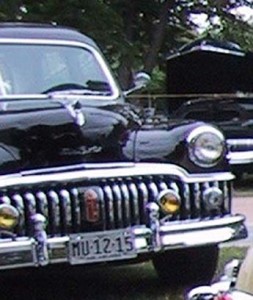Today’s cars come so well equipped, and factory-priced accordingly, that the auto accessory market has dwindled hugely compared to what it Yoostabee (used to be).
So today, Yoostabee, my alter ego, is going to turn back the calendar, a few decades, to the 1940s, and tell you how car nuts “used to” tailor their wheels for their needs and egos.
Indeed, in the sellers’ market right after World War II, new car buyers were compelled by new-car dealers, many of whom barely managed to stay afloat during the war years and now were playing catch-up, to accept expensive accessories on top of the full “list” price they paid for much sought after new cars. Veterans returned from the war with cash in their pockets for a new car. Prices of used cars were inflated. There was pent-up demand from essentially four years of no new cars or trucks.
Some of the most common accessories mounted on new cars of the times—and buyers had to accept them if they wanted those new wheels—were fog lamps (twin, yellow, front bumper-mounted), sunshades mounted to the A-pillars and shading the two-piece windshields of the time, and straw-and-fabric seat covers to go over the factory mohair upholstery. The last were fairly practical because, by protecting the original trim, they enhanced the value of the car when it was eventually sold or traded in.
But the others were, excepting in very limited circumstances, pretty useless. An exception, though, was the 1947 Chevrolet coupe our next door neighbor bought when he got out of the Army; he was a medical doctor in an era when doctors still made house calls, and needed the spotlight to find street signs and house numbers.
These were only a few of the accessories of the times. Car owners bought many accessories because they were practical—and later became, in stages, standard equipment included in the price of the new car. For example, I mounted a left-hand outside mirror on my mother’s inherited 1941 Plymouth that I learned to drive in, as well as one on my father’s 1946 Nash Ambassador that I occasionally drove. (I doubt if my parents ever used them, because they had learned to drive without outside mirrors.)
What’s the difference between an accessory and an option, you may ask. An option is listed by the factory, and at times also could be sold after-market as an accessory. But not all accessories made it to the option table, unless auto manufacturers deemed them potentially profitable enough to invest in engineering, purchasing, warehousing and cataloguing.
On the 1949 Plymouth that eventually replaced the ’41, the mirror was now standard, but I mounted accessory turn signals and a back-up light illuminated by a pull/push switch under the dash. In addition, I also bought an accessory Motorola “500” six-tube, no push-button radio, bolted to the right kick panel with cables to on/off volume and frequency knobs on the dash. It originally cost $40 installed. I subsequently moved that radio to a ‘52 hand-me-down Dodge and a new ‘55 Plymouth V-8, both of which by then offered standard turn signals and backup lights. Altogether, when I eventually sold the ‘55 with than 100,000 miles on the odometer, that radio had provided me entertainment for 14 years.
For my father’s ‘58 Rambler American, I had accessory front-seat lap belts mounted, though I don’t know if he ever had the discipline to fasten them in the four years he continued to drive. By then, the major automakers all offered seat belts as dealer-installed factory options.
My inducement to pull together this memoir of Yoostabee automotive accessories was triggered by an older model Oldsmobile I saw in a Kroger’s parking lot. The Olds had somewhat battered plastic shields over the tops of the side window openings. Made of aluminum in an earlier era, these rain shields were another after-market accessory popular especially in Southern states in the post-war years before air-conditioning, as a way to crack the windows to relieve sun-baked heat or provide ventilation and still avoid rain getting in.
Some other largely forgotten auto accessories included curb feelers to protect white-sidewall tires from scrapes when parking; added horns which sounded better than the single tones on some cars; mud flaps if you drove over muddy roads; as a statement of personalization, “cat’s eye” rear light lenses and, honest, even raccoon tails to hang on the radio antenna. Fender skirts, or if you prefer, fender pants, were another add-on personalization accessory, as were white-sidewall tires, especially on older, low series models. In the city where I grew up, we teenagers immediately identified such over-accessorized cars as being “from the country,” to put it in nice terms. A bit of elitism, you might say.
A car owner (or his teenager) could buy most of these ad-ons at the corner gas station, a hardware store, a car dealer’s parts counter or through the catalogue of a company like J. C. Whitney of Chicago, which today is still in business but working through a website as well as mailed catalogue.
Today, many of yesterday’s options have become standard equipment. Initially this was fomented by the Federal Motor Vehicle Safety Standards, whose originators first reached into the grab-bag of available optional “stuff” to require as standard. Then along came masses of Japanese imports that arrived across the Pacific well-equipped with “standard” equipment because of their long pipeline and what turned out to be very sound marketing. Domestics were forced to up-equip their cars, particularly those stripped for minimum sticker price, traditionally at the lower ladder rungs, in order to compete with Asian imports.
The last after-market accessories I can recall buying, more than 30 years ago, for one of my cars were a supplemental, enclosed rooftop carrier for a station wagon, and cup holders for a variety of cars until manufacturers began building them in.
And that’s how it “Yoostabee.”

